 username@email.com
username@email.com
In this lesson, you will review environmental cycles, energy flow, primary and secondary succession, climax communities, abiotic and biotic factors, and biomes.
Understanding evolution, niches, ecosystems, and relationships between living things includes behind-the-scenes processes. Behind-the-scenes of all living systems is the movement of nutrients. Nutrients are central to the systemic survival of Earth’s ecosystems. Biogeochemistry is the study of nutrient movement through both the biological and geological layers of the ecosystem.
Nutrients, such as nitrogen (N), phosphorus (P), and carbon (C), are among the 16 chemical elements necessary for growth. Plants, microbes, animals, and organic matter are the biotic locations of nutrients. The atmosphere, water, and soil represent the abiotic locations. Nutrients are also stored in sediments, rocks, and oceans. Nutrients are constantly cycling through biotic and abiotic systems. Biological, chemical, and geological processes transform nutrients into resources beneficial to living things.
Carbon is one of the primary biogeochemical cycles studied by scientists. Earth stores carbon in dead and living organisms, in the atmosphere as carbon dioxide gas, and in soil as organic matter. Carbon is present in fossil fuels, rock deposits, and marine organisms. The movement of carbon is a complex cycle. The most familiar process in the carbon cycle is photosynthesis. During photosynthesis terrestrial plants take in atmospheric carbon dioxide. Through respiration plants release oxygen. Humans have had a significant impact on the carbon cycle. Burning fossil fuels is releasing increasing amounts of carbon dioxide into the atmosphere as greenhouse gases. Agricultural practices including deforestation, soil cultivation for food production, and reforestation also have a significant impact on atmospheric carbon dioxide levels.
The nitrogen cycle is another biogeochemical cycle. It is also one of the most important cycles in terrestrial ecosystems. Nitrogen is used by living things to produce organic molecules, such as proteins, nucleic acids, and amino acids. Soil, oceans, and the atmosphere hold stores of nitrogen. The largest nitrogen store is the Earth’s atmosphere. Plants take up nitrogen as nitrates and ammonium. By consuming dead or living organic matter, animals obtain the nitrogen they need for growth, reproduction, and metabolism.
Human activity has significantly altered the nitrogen cycle. The following are some human practices that have affected the nitrogen cycle:
In addition to human factors, there are other causes that reduce the amount of nitrate available to plants. Erosion is the process of soil particles being carried away by wind or water. Nutrients are carried away in the eroding soil. As water percolates through soil, it carries nutrients dissolved in it. Water may leach too deeply into soil moving the nutrients out of reach of roots. Nutrients in volatile forms, such as nitrogen and sulfur gasses, escape into the air and are lost.
Water plays an important role in both the carbon and nitrogen cycles. Water movement enhances the cycling of nutrients in the leaching process, as it is responsible for dissolving and carrying nutrients to and from plants. Soil organisms and plants need water to survive. The movement of water can also cause problems. The power of water can be a destructive force, contributing to runoff, erosion, and soil compaction. Proper water and soil conservation practices can help reduce these problems.
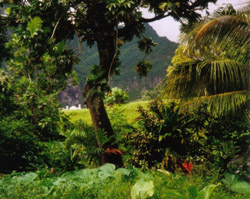
Amazon rainforests provide one example of the complexity and impact of nutrient cycling. Based on the enormous vegetation of these tropical rainforests, it was once thought that their soils were rich. Scientists now know that rainforest soils are actually “wet deserts.” The yellow and red clay-like soils are nutrient poor. These are considered to be “old soils.” The Amazon does not have the benefit of volcanic activity that would bring significant nutrients to the soil. As a result, the soils lack critical mineral resources, such as calcium, magnesium, phosphorus, and potassium. It turns out that the abundance of nutrients in rainforests is stored in the plant matter itself. Vital minerals are constantly being processed and reabsorbed into the system. Everything is constantly breaking down and returning to the system to maintain the massive volume of living plants. Some plant species are so highly adapted for this process that they have root systems forming a mat on the forest floor to efficiently obtain nutrients.
Vast expanses of rainforest have been cleared for agricultural use. Agriculture practices have quickly depleted the minor reserves of minerals present in the soil. These tracts of land have been exhausted without the contributions of water and nutrient cycling. No longer viable for agriculture they have been abandoned in favor of newly deforested land. The process of reforesting these large tracts of land has met with limited success. Many rainforest species need the systemic combination of decomposition, nutrient cycling, and deep shade of more mature plants to grow. Too much sun, depleted soil, and the lack of incoming nutrients make it difficult for rainforests to recover at their former level of diversity. Smaller tracts of deforested land have recovered with more success. These areas have enough surrounding rainforest to contribute vital nutrients to the recovery process. Still, even these areas of secondary growth are less diverse than the original rainforest habitat nearby.
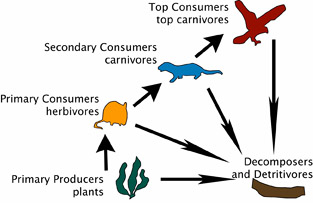
Sunlight, water, and carbon are central to the energy conversion that is photosynthesis. Plant production of simple sugars becomes the energy of growth and reproduction. The sun’s energy converted by plants into simple sugars is the starting point of any food chain. Plants are the producers, which are organisms that create their own food. Animals obtain converted energy by eating plants. Animals are consumers. As consumers they cannot create their own food. Herbivores are consumers that rely entirely on plants for their food. Omnivores are animals that obtain their energy from both plant matter and other animals. Carnivores obtain all of their energy by consuming other animals.
Each level of consumption in the food chain is called a trophic level. Producers are the first trophic level and are the beginning point for transfer of the sun’s energy to all other living things. As it is transferred from one trophic level to the next some energy is lost as heat. A biomass pyramid is one expression of the movement of energy through the trophic levels. The lower trophic levels contain the most energy. Energy is lost as it is transferred from one level to the next. The upper levels of the biomass pyramid have less total biomass as a result of the lower energy availability.
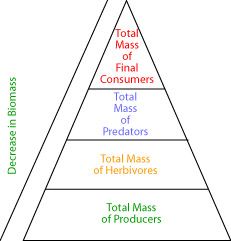
A pyramid of numbers is an expression of the amount of organisms in a trophic level. The type of ecosystem determines the shape of the pyramid. For example, a forest ecosystem may have a limited number of large trees. However, the trees successfully support a number of bird species and an even greater number of insects.
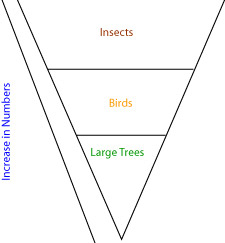
By contrast an ocean pyramid of numbers would reflect an enormous number of algae, fewer herbivores, and even fewer carnivores.
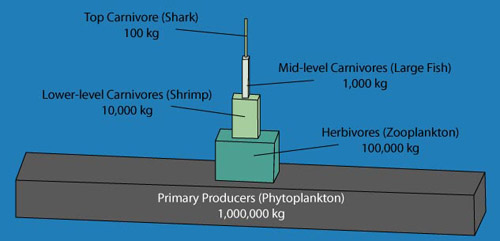
A pyramid of energy reflects the production rates in each trophic level. Using the ocean example again, consider the rapid reproduction rate of algae. Algae populations take only a few days to double. Zooplankton feed on the algae and may double in population in a few months. The fish feeding on the zooplankton may only reproduce a single time each year. A pyramid of energy reflects the turnover rate of a population. This pyramid cannot be inverted.
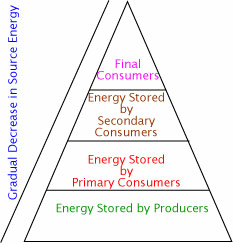
Across the trophic levels, some energy remains unconsumed or is excreted as undigested material. This potential energy does not go unused. Detritivores survive on the waste products of the ecosystem. Detritivores include the scavengers, such as vultures, who consume carrion or the matter of dead animals, and the decomposers, such as ants and worms, that consume organic matter. They all serve as recyclers breaking down nitrogenous waste products and dead organisms. Consumers of detritivores access the energy of their clean-up work and bring it further into the food web.
As species change and evolve over time, so do ecosystems. Ecosystems go through constant, observable processes of change and restructuring. Over time, some species may become more abundant while others decline or even disappear. As time marches on, so does the composition of inhabitants of an ecosystem resulting in ecological succession.
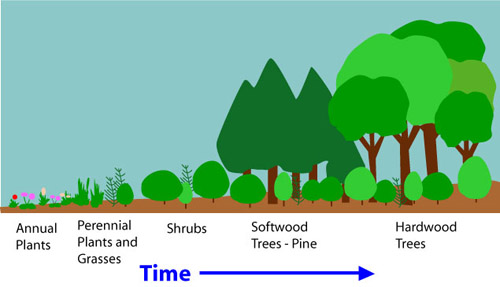
Succession processes that may be recognized by the presence of certain species. During particular parts of the orderly series of changes, certain species will be more prevalent. This prevalence enables scientists to roughly identify the stage of succession underway in a community.
Dwight Billings conducted some of the earliest research about succession. He made his observations using North Carolina’s abandoned agricultural fields. He observed fields abandoned only a few years. He compared those with fields abandoned up to 150 years. He observed that during the earliest years of abandonment, annual plant species infiltrated the fields. These pioneer species had single growing seasons as their lifespan. They grew to maturity quickly and produced a large number of small, easily spread seeds.
Grasses and biennial plants quickly took over for the annuals. They may have grown for a few years before perennial shrubs and herbs began to make their way into the system. The shrubs and herbs were longer-lived and reproduced many times over their lifespan. Slowly the North Carolina fields were then inhabited by softwood tree species. Loblolly pine, Virginia pine, and shortleaf pine were observed. A forest canopy formed. This gave way to understory characterized by increasing amounts of shade. At ground level, the air was still and increasingly humid. These conditions promoted the germination of hardwood seeds. Soon oak and hickory trees began appearing. As the softwoods reached their maximum age, the hardwoods grew into position to take over. Billings suggested that succession from pioneer perennials to a hardwood climax community took about 120 years.
More recently scientists have identified two types of succession. Primary succession occurs in places previously unoccupied by vegetation. Lava flows, newly emerged volcanic islands, soil rubble exposed by major landslides, the remnants of open-pit mining, and receding glaciers are all locations for primary succession. Characterized by exposed rock and soil these locations take thousands of years to slowly succeed towards a climax community.
Secondary succession occurs as the re-establishment of viable, stable communities following deforestation, abandonment of agricultural sites, and flooding or hurricane conditions. Similar to primary succession, secondary succession is expressed in a sequence similar except with a different starting point. As a result of any of these disturbances, secondary succession maximizes the remaining topsoil and organic life to begin anew.
In primary and secondary succession the re-vegetation process is driven by new species out-competing existing species. For example, the extensive root systems of tall grasses enable access to nutrients and moisture needed by wildflowers. Eventually the tall grasses put the wildflowers out of business. Later the tall grasses will be overpowered by the increased shade produced by new tree growth. As plant species transition to species better fit for the environment, the process also causes an influx of new animal species better fit to the new environment. Slowly the entire system moves towards increasing stability known as a climax community. In the absence of climate or land changes, a climax community can support a consistent species composition. Eventually the community becomes so well-established it is self-sustaining. These climax communities are the foundation of Earth’s diverse biomes.
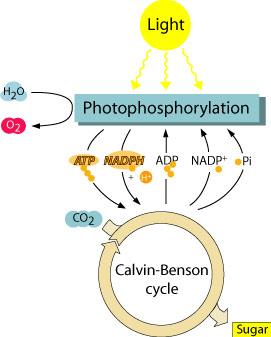
Evolution, interdependent relationships, symbiosis, competition, and reproductive success are the biotic factors influencing all living things. Biotic factors are those living items in a given environment. This is half of the survival equation. The other half of the survival equation relates to abiotic factors. Abiotic factors are the non-living items in a given environment. Abiotic factors have a direct affect on global and local species distribution. Wind, water, sunlight, temperature, soil, rocks, and periodic disturbances are all abiotic factors. These factors affect species where they live. For example, wind can speed evaporation of moisture from soil or increase dehydration in animals. Freezing or extreme heat can quickly affect an entire population of species. Those unable to migrate are impacted by temperature extremes. Soil is necessary for all plant growth. This makes it an important abiotic factor for the success of any ecosystem. Sunlight is the first element of any food chain. Sunlight launches plant photosynthesis, contributes to productivity in aquatic habitats, determines vegetation in all layers of the forest, and for some animals, determines breeding cycles and lifestyle.
Fire is an example of an abiotic periodic disturbance. Fire is part of a natural cycle of transforming accumulated leaf litter and undergrowth into nutrients in the soil and making way for new growth. Some species of plants need fire to trigger seed dispersal or initiate germination. In the past, humans have mistakenly controlled fires in the western United States. Controlling the natural process of forest fires has meant an increase in the amount of leaf litter and undergrowth. Subsequent fires burn hotter consuming the abundant fuel available from fewer previous fires. Less frequent fires negatively impacts plants that rely upon them for reproduction and growth.
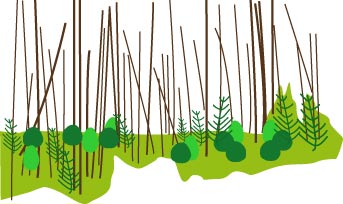
Abiotic factors are one aspect of the physical definition of biomes. A biome is a large geographic region characterized by a specific type of climate and certain types of plant and animal communities. Biomes are heavily dependent upon the combination of geography and climate. Climax communities are the foundation of biomes. Forests, deserts, grasslands, and aquatic regions are examples of some of Earth’s major biomes.
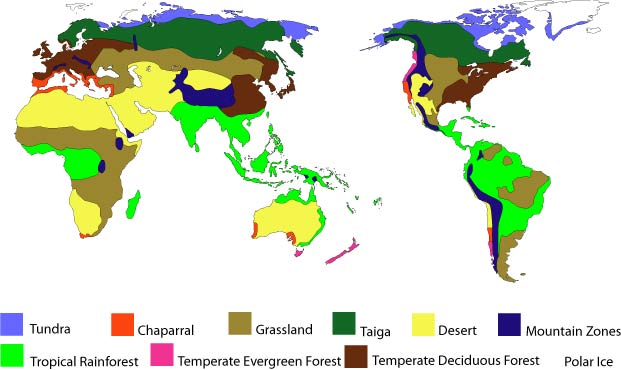
Tropical rain forests are perhaps the most ecologically complex biomes. Plants, trees, microorganisms, insects, invertebrates, amphibians, reptiles, and mammals are all found in the varying climatic conditions of Earth’s forests. Found along the Earth’s equator, tropical rainforests contain richly diverse ecology.
A tropical rainforest basks in 12 hours of daylight and virtually no winter season. Characterized by a short dry season and a prolonged rainy season, vegetation growth is abundant. Rainforests are capable hosts of well-adapted plant and animal species. Diverse adaptations—giant leaf size, enormous buttress roots, camouflage, mimic coloration, and symbiotic relationships—enable rainforests to be highly productive, self-sustaining climax communities.
Temperate broadleaf deciduous forests can be observed in eastern North American, eastern Asia, and western and central Europe. These climax communities receive up to 152 centimeters of rain distributed throughout the seasons. They experience winter months including the implications of snow and ice. Cooler fall weather causes the tree species to drop their leaves adding nutrient resources to the rich soil of the forest floor. Temperate broadleaf deciduous forests are characterized by tree species such as elm, linden, walnut, oak, maple, hickory, and chestnut. Squirrels, raccoons, opossum, and black bear are among the mammal inhabitants. Insects are abundant and are connected to the bird species present in this biome, including thrushes, warblers, hummingbirds, wrens, woodpeckers, and chickadees. Birds successfully migrate out of this biome to warmer temperatures during the winter months returning to the highly productive biome for breeding during the summer season.
About one-fifth of Earth is covered by desert biomes. The extremely low rainfall these biomes receive each year defines deserts. In a setting where water is at a premium, climatic conditions may cause evaporation to exceed the annual rainfall. Vegetation is sparsely distributed in desert biomes with adaptations to maximize moisture storage while minimizing the impact of evaporation. Where forest trees have leaf sizes ranging from medium to enormous, desert plants are minimalists. Some desert species are annuals with short life cycles that take full advantage of brief wet periods.
Deserts can be geographically and climatically defined. Ranging from arid to semi-arid to coastal to cold deserts, soil make-up combined with heat and rainfall determine the environmental factors. In turn, these factors limit plant and animal life to a sparse few species with highly specialized adaptation strategies. Animals take advantage of nightfall and come out in the cooler darkness to access food resources and to breed. Many live in burrows to avoid the extreme daytime heat.
South African veldt, Asian steppes, South American pampas, and North American prairies are all grassland biomes. All have in common their inland nature and 3.9 – 7.8 inches of annual precipitation, much of which occurs in the form of snow. Perennial grasses, grazing mammals, herbivorous rodents, and ground nesting bird species take advantage of the characteristics of grassland habitat. Humans have exploited grasslands extensively for agricultural development.
Seventy-five percent of Earth is covered by water. Billions of years ago life began in the ocean. From deep ocean floors to rocky mountain streams, aquatic biomes support a diverse array of species adapted for life in the water. The largest and most diverse ecosystems are oceanic. Oceans are home to abundant algae that contribute most of the oxygen in Earth’s atmosphere, as well as marine species taking advantage of open ocean, intercoastal, tidal, coral reef, and estuary habitat. Inland freshwater lakes, wetlands, ponds, and rivers define aquatic ecosystems. Each is characterized by the water and geologic features that support plant and animal life. Scientists have much to learn about the productivity and abundance of the aquatic ecosystems.